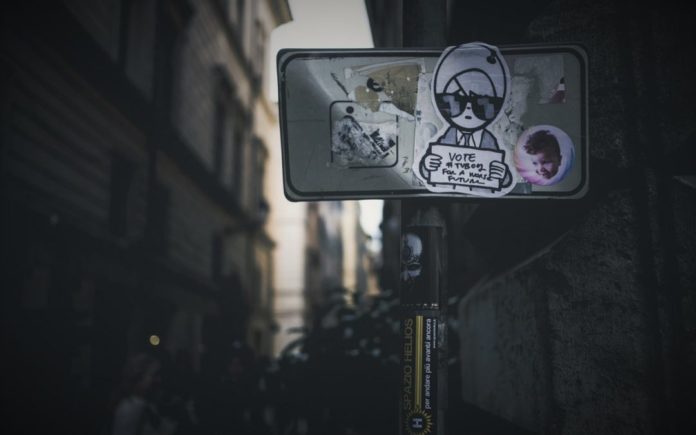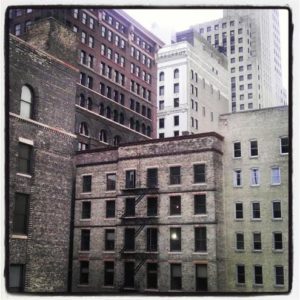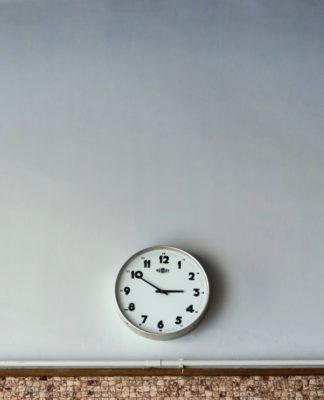
There’s not the bustle in downtown St. Paul that you’ll find in larger cities around the country, but that is changing. 5th Street is one of the main arteries running through downtown. It has the potential to be one of the best routes for a stroll from west Rice Park to east Mears Park, and on to CHS field where the St. Paul Saints play ball.
5th Street’s pros and cons also represent the pros and cons of downtown as a whole:
On the one hand, you have the Xcel Energy Center, Roy Wilkins Auditorium and Ordway Center For the Performing Arts. 5th Street takes you by some of downtown’s most important cultural attractions.
The Landmark Center, the premier cultural center of the city, overlooks Rice Park and defines the western edge of the street. Built in 1902 as a courthouse/government building that saw the trials of some of the Midwest’s most notorious gangsters, the building remains as a testament to the grandeur St. Paul once embodied. Now, the building hosts two museums open to the public, the Gallery of Wood Art and the Schubert Club Museum, as well as concerts and other events supporting arts and culture in St. Paul.
You will also pass the historic Saint Paul Hotel, the beautiful Lowry Building with grand Italian restaurant Pazzaluna at the base, the colorful Saint Paul Conservatory for the Performing Arts and, just shy of Wabasha, Subtext, downtown’s first bookstore in decades which operates in quiet elegance next door to the Conservatory.
You will also pass a Chipotle, Starbucks and Dunn Brothers.
And, on the other hand, you have
The Dead Zone
where there are more than a few challenges facing pedestrians after crossing Wabasha Street. Much of 5th is unfriendly – blocks of cement walls, one-way windows, and buildings without storefronts make it a modernist hell in places.
There’s also the giant empty lot between Minnesota and Cedar Streets, cut down the middle by Central Station. This, perhaps more than anything, represents the duality of downtown: It’s the busiest transit center in the city; buses and Green Line LRT converge for an almost constant flow of people. But it’s also a big hole of grass and mud in the midst of a dense urban landscape. Undeveloped, full of untapped potential, waiting to rise again.
Endicott Arcade, connected to the Pioneer-Endicott Buildings, provides 5th Street with limited retail options. Built in 1910, the storefront briefly housed Phenom and an E-Cig store, and is still home to a small market, Adam’s Market, that sells minor groceries and sundries.
 The Hat Trick Lounge, a dark dive that often hosts inspired, or at least interesting, musical acts, and an even more interesting cast of characters hanging on its outdoor patio, is the largest tenant. The cigarette smoke and oddball conversations you’ll pass here will either remind you of an early Tom Waits song, or the rough-around-the-edges culture that is being scrubbed out of downtown, depending on how you feel about it.
The Hat Trick Lounge, a dark dive that often hosts inspired, or at least interesting, musical acts, and an even more interesting cast of characters hanging on its outdoor patio, is the largest tenant. The cigarette smoke and oddball conversations you’ll pass here will either remind you of an early Tom Waits song, or the rough-around-the-edges culture that is being scrubbed out of downtown, depending on how you feel about it.
If Jim Crockarell has his way, however, the entire arcade will become the lobby of a boutique hotel planned for the connected Empire Building next door.
While too many of the historic buildings on 5th Street were lost to urban renewal, a few grand historic buildings remain. The Empire Building is one of these; as is the Endicott Arcade. The most impressive in The Dead Zone, however, are seen from the rear (pictured above right). The best architecture actually on 5th Street lies further east in
Lowertown
The 180 East Fifth Building is a grand building and stands guard at the entrance to Lowertown. Completed in 1910, the building was clearly built to last. It’s a structure of solid brick and steel, with soaring columns and other neo-classic details, and interior event space that recalls classic ballrooms from old movies; a place where a Billy Wilder romance might have culminated.
This is where 5th Street blossoms once again. The green of overhanging trees and historic warehouses of Lowertown help to forget the previous four blocks. You’ll hit Mears Park to your left at Sibley Street, with it’s flowing stream and meticulously cared-for gardens and trees. To your right is some of the finest preserved architecture in the city.
Crossing Wacouta, the renovation of the Rayette Building continued the trend of historic warehouses being converted into market-rate lofts, apartments and condos. Even more exciting than the addition of another market-rate condo building in Lowertown was the opening of Saint Dinette on the first floor overlooking the Farmer’s Market.
And, at the very end, is CHS Field. 5th Street leads you right to the front gate of the award-winning St. Paul Saints ballpark.
The 5th Street of the future
While 5th Street does feel virtually unwalkable in places, and could use more than a little beautification along much of the sidewalk, it is an important route through downtown and is home to many unique St. Paul destinations.
Sibley Square has been converted into 333 on the Park, which will bring (more) high-end lofts, with retail options at street level, to 5th Street. This, coupled with World Of Beer bringing 500 different brews into a long-vacant space in the Straus Lofts across the street, continues the trend (for better or for worse) of a vibrant Lowertown.
The section of the mayor’s downtown plan Prosper: Momentum Is Building is dedicated to Central Station. It calls for a creative redevelopment of the lot; perhaps even a building that would allow the train to pass beneath it (pictured right).
And if the boutique hotel planned at the Empire Building (corner of 5th Street and Robert) is a success, that will add necessary foot traffic. It also adds the need for more to do, and more retail options on or near 5th Street.
With a little work, and a little TLC, 5th could become the main line from Rice Park to Mears Park and to the ballpark; the type of street that represents the new downtown, and a new era for St. Paul.
















